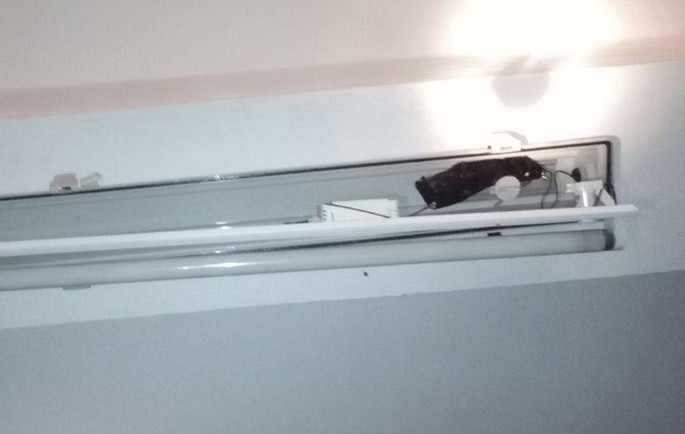
A microphone found inside a neon ceiling light in Modena, Italy, in December 2015.
Covert audio surveillance devices are electronic devices, typically microphones, hidden by an adversary to collect audio data.
An adversary can hide covert audio surveillance devices anywhere interesting audio data, typically conversations, can be collected. Notable locations include:
- The living room of a target.
- The dashboard of the vehicle of a target.
- An outdoor location where a target regularly meets or is expected to meet other people.
Covert audio surveillance devices can be very sensitive and successfully pick up conversations even when there is loud music playing in the background or people are whispering. They can be extremely small — just a few millimeters — especially if they record locally (e.g. on an SD card) and do not transmit their recordings.
Recorded conversations can be used as evidence in court if incriminating matters are discussed, or if they can be misconstrued to appear incriminating in the eyes of a judge. Non-incriminating, mundane conversations can reveal a great deal about the targets of surveillance and help in network mapping.
See Ears and Eyes and the hidden devices topic.
Used in tactics: Incrimination
Mitigations
| Name | Description |
|---|---|
| Bug search | You can conduct a bug search to locate covert audio surveillance devices and eventually remove them. |
| Outdoor and device-free conversations | You can conduct sensitive conversations outdoors and without electronic devices to prevent an adversary from recording those conversations with covert audio surveillance devices. |
| Physical intrusion detection | An adversary often needs to covertly enter a space to install a covert audio surveillance device in the space. You can use physical intrusion detection to detect such a covert entry. |
Used in repressive operations
| Name | Description |
|---|---|
| Renata | Six hidden microphones and a camera were found in a house after the operation[1]. The microphones were found in the living room, hallway, and bedrooms. The camera was found in the intercom system. See the corresponding Ears and Eyes case. |
| Scintilla | Microphones hidden in a house for two and a half years recorded conversations that the investigators used to prove that the accused comrades knew each other, talked regularly, worried about the creation of a DNA database and the impossibility of resisting DNA collection, and discussed writing a text to be published[2]. See the corresponding Ears and Eyes case. |

